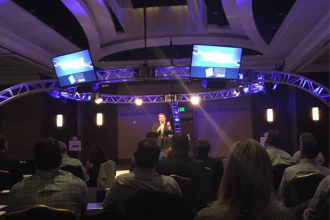InfoComm: Cracking the Healthcare AV Market
This column was reprinted with permission from InfoComm and originally appeared here.

By Brad Grimes
Laura Adams, CEO of theRhode Island Quality Institute, has a request for those of you working in AV and IT: work together on a way to incorporate video into electronic health records. Speaking this week on the opening panel of the inauguralTechnology Crossroads Conference, co-produced by InfoComm and the National eHealth Collaborative, Adams told a roomful of attendees about a friend and colleague with incurable cancer and her carefully considered desire to live her life to its fullest, right up until she dies. No aggressive treatment, no matter what. And it’s Adams’ desire that there will come a day when someone like her friend can record her wishes and that video recording will follow her electronically so that every healthcare provider she ever meets can view it and understand how she wants to be treated—or not treated.
Adams’ story was a powerful reminder of why healthcare — the AV industry’s fastest growing market—is unlike any other market that AV companies serve. The advanced technologies that healthcare experts like Adams envision — whether it’s a universal video record standard or a telemedicine system — may have a direct impact on people’s well-being. The Technology Crossroads Conference was conceived to begin building bridges between the two sides. Healthcare IT professionals spent two days learning what today’s AV systems offer, and AV professionals learned what it will take to develop solutions that the healthcare industry wants and needs. Because one size does not fit all.
For example, if you haven’t worked in healthcare you might not know what Mark Valenti (pictured above), CTS, President and CEO of The Sextant Group, told attendees: that all those touch screens going into corporations and other settings are just a passing fancy to healthcare providers because in their world, germs are especially bad. Valenti cited experiments at using gestures to view patient records and images without having to touch anything.
In addition, you might not know that project execution in the healthcare market is changing and healthcare clients are some of the earliest adopters of integrated project delivery (IPD), based on their desire to better control cost and risk. Valenti, whose AV consulting firm has extensive experience with healthcare clients (some of the codecs they spec’d for a hospital system in 1996, cost $108,000 apiece!) said any AV company that wants to work in healthcare should learn IPD.
And the security needs of healthcare clients are particularly acute. As Robert Wah, M.D., Vice President and Chief Medical Officer at IT integrator CSC, explained, when consumers’ health information is compromised, they’ll shy away from using any of the high-tech systems you might help install. Sure, we’ve seen credit card numbers end up on the Internet, he said, and that’s a major security breach, but people can recover from having that information exposed (granted, it can take several years). However, if a patient’s health information ends up on the Internet—their diagnoses, consultations, etc.—“That’s a bell you cannot un-ring,” Wah said.
Scott Whyte, Vice President for IT connectivity at Dignity Health had recommendations for AV professionals trying to sell into the healthcare market. He said he recognizes that customers in various markets always say their market is different, “But healthcare really is different. So be patient with [customers] when they try to explain why their requirements are different from [customers’] in another state.”
But make no mistake: Many of the technologies that healthcare providers see as critical to their evolution are right in AV pros’ wheelhouse. Videoconferencing and telemedicine may be the poster children for healthcare AV, but throughout the Technology Crossroads Conference, we heard of bread-and-butter AV solutions that hospitals and other healthcare facilities need, like good old-fashioned routing and switching. Scott Chester, CTS-D, and Steven Juett, of RTKL Associates, described modern operating theaters, festooned with displays for watching real-time procedures, analyzing medical imagery, and more, requiring the ability to route a variety of sources to any screen in the room. Sound familiar?
Barry Goldin, CTS, Vice President at Audio Video Systems, detailed the Simulation Center at Indiana University Health’s Fairbanks Hall, where the education of next-generation doctors and nurses is captured and streamed to rooms throughout the facility for evaluation and collaboration. And several presenters touched on the importance of high-resolution imagery — because displaying digital signage is nothing like displaying high-precision medical scans, models, and other visual information.
As in other markets, AV professionals should understand the business of potential healthcare clients. For example, incentives for healthcare providers to adopt electronic health records is spurring rapid technology adoption. That said, there’s increased pressure to reduce costs (some healthcare firms, despite an overall shortage of qualified care providers, have gone through layoffs). And the entire industry is beginning to pivot from a fee-for-service model to a fee-for-outcome model. AV pros need to understand all the dynamics so they can come up with applicable solutions.
Like other markets where the intersection of AV and IT has led to huge opportunities, healthcare is ready for innovative solutions. Just be aware, it’s a business like no other. Said Dr. Bill Braithwaite, a pioneer in the field of medical informatics and considered by many to be the father of the Health Insurance Portability and Accountability Act (HIPAA), there are “just” three criteria for selling AV systems to healthcare providers. “To deliver high-quality healthcare, at less cost, and in less time.”
Simple enough? Start doing your homework.





